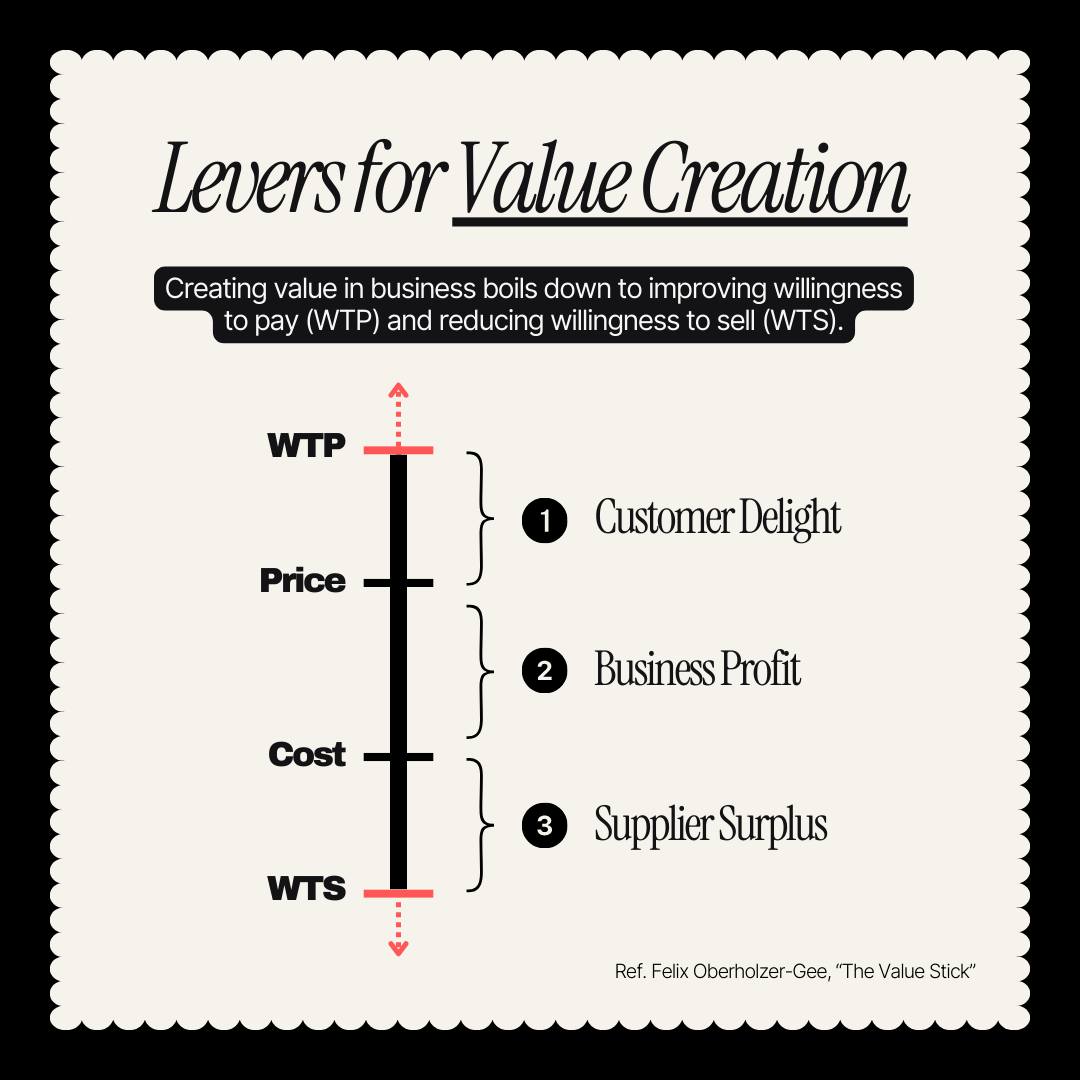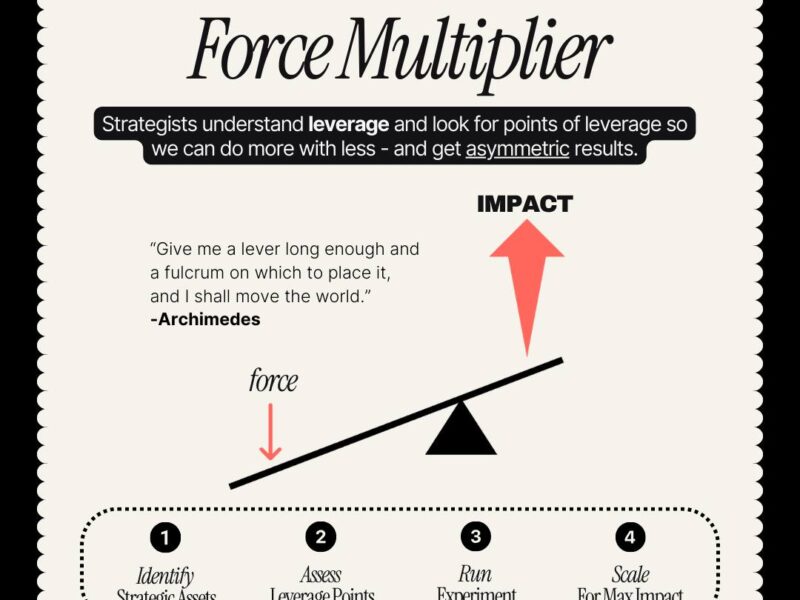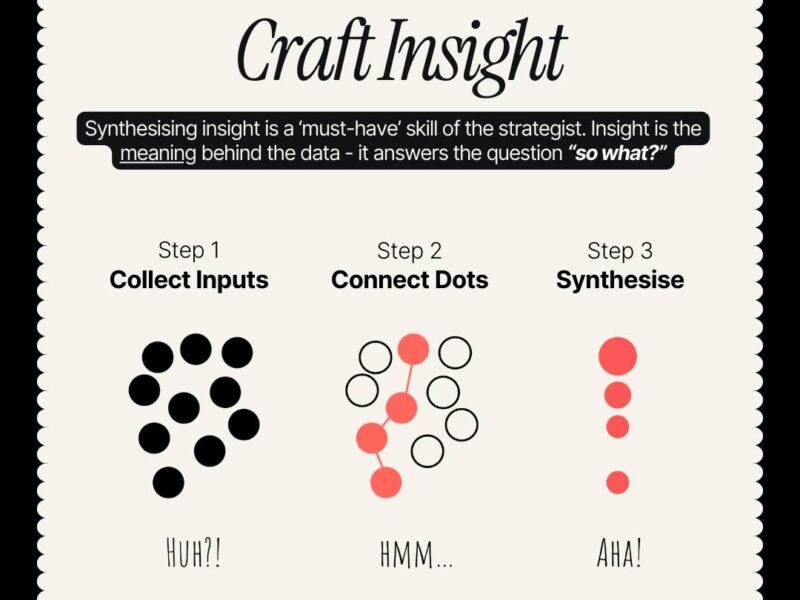A Strategic Blueprint for Business Leaders
In the relentless pursuit of growth and competitive advantage, business leaders are often overwhelmed by an avalanche of metrics, including CAC, LTV, NPS, EBITDA, and numerous others. While these are vital signs, they can distract from the fundamental equation that underpins all sustainable business success: Value Creation.
True, lasting value is not created by optimizing a single metric in isolation. It is engineered by systematically widening the gap between what your customers cherish and what your suppliers require. This is not a vague concept; it is a precise, measurable, and manageable dynamic. In this article, we will deconstruct this dynamic using a powerful framework—the Value Stick—and translate it into a strategic blueprint, complete with the tools, inputs, and outputs that I, as a UX Designer and Solutions Architect, have used for over two decades to build products and systems that win markets.
The Fundamental Equation: Deconstructing the Value Stick
At its core, value creation is defined by a simple but profound equation:
Value Created = Customer’s Willingness-to-Pay (WTP) – Supplier’s/Employee’s Willingness-to-Sell (WTS)
This concept is elegantly captured by Harvard Business School professor Felix Oberholzer-Gee in his “Value Stick” framework [1]. Imagine a simple stick. At the very top is the customer’s Willingness-to-Pay (WTP)—the absolute maximum amount they would pay for your product or service. At the very bottom is the supplier’s or employee’s Willingness-to-Sell (WTS)—the minimum they would accept to provide their goods, services, or labor.
Between these two poles lie two critical points:
Price: The actual price the customer pays.
Cost: The cost your business incurs.
The spaces between these four points create the three zones of value that every leader must master:
Customer Delight (WTP – Price): The consumer surplus. The joy a customer feels from getting a product they value highly for a price that is less than their maximum.
Business Profit (Price – Cost): Your margin. The lifeblood of your enterprise.
Supplier Surplus (Cost – WTS): The provider surplus. The satisfaction a supplier or employee feels from receiving a price (or wage) that is above their minimum threshold.
The strategic imperative is clear: to create more value for all stakeholders, you must either raise the top of the stick (WTP) or lower the bottom of the stick (WTS). Every strategic decision, especially in technology and product design, can be evaluated through this lens.
Let’s now dissect each lever, moving from theory to practical execution.
Lever 1: Maximizing Customer Willingness-to-Pay (WTP)
Raising WTP is not simply about charging more; it’s about making your product or service worth more in the eyes of your customer. This is where the art of UX design and the science of product strategy converge.
The “Why”: The Power of Customer Delight
A large gap between WTP and Price signifies high customer delight. This is your primary defense against competition and your engine for growth. Delighted customers are less price-sensitive, more loyal, and become organic evangelists for your brand.
The “How”: Strategies and Frameworks
Product Innovation and Superior Utility:
Jobs-to-Be-Done (JTBD) Framework: Stop defining your product by its features. Instead, understand the fundamental “job” a customer is “hiring” your product to do [2]. A milkshake’s job might be “to make my boring commute more engaging and satiating.” Understanding this allows for innovation focused on the outcome, not the feature (e.g., making it thicker to last longer).
Input: Customer journey maps, ethnographic research, customer interviews focused on progress and struggle.
Output: A prioritized roadmap of features and improvements that directly address core customer jobs and pains.
Seamless User Experience (UX) and Design:
Frictionless Interaction: Every moment of confusion, every unnecessary click, and every slow load time erodes perceived value. A flawless, intuitive, and even delightful user experience directly increases WTP. Think of the premium people are willing to pay for Apple products; a significant portion of that is for the seamless ecosystem and intuitive interface.
Tools: Figma/Sketch (for prototyping), UserTesting.com (for validation), Hotjar (for behavior analysis), Design Thinking workshops.
Input: Usability heuristics, user flow diagrams, prototype feedback, performance metrics (e.g., page load time, task completion rate).
Output: High-fidelity prototypes, validated user interfaces, a style guide, and a product that feels effortless to use.
Brand Building and Emotional Connection:
Storytelling and Values: A strong brand stands for something. Customers’ WTP increases when they feel an emotional alignment with a brand’s values. Patagonia’s commitment to sustainability allows it to command premium prices because customers are buying into a mission, not just a jacket.
Input: Brand positioning statements, market segmentation, content strategy.
Output: A consistent brand narrative across all touchpoints, from marketing copy to the in-app microcopy.
Best Practices for Increasing WTP:
Measure WTP Directly: Use techniques like Van Westendorp’s Price Sensitivity Meter [3] or conjoint analysis to quantify how much value customers assign to different features.
Focus on Outcomes, not Outputs: Measure success by the customer’s achieved outcome (e.g., “successfully published a blog post”) rather than your team’s output (“built a new text editor”).
Iterate Relentlessly: Use agile methodologies and continuous deployment to learn from user behavior and improve the product weekly, if not daily.
Lever 2: Optimizing the Business Profit (The Margin Engine)
This is the lever most familiar to executives: the difference between Price and Cost. However, the Value Stick reframes it. You don’t just “cut costs” or “raise prices” arbitrarily. You create room to do so by manipulating WTP and WTS.
The “Why”: Fuel for Growth and Innovation
Profit is not a dirty word; it is the oxygen that allows a business to invest in R&D, weather economic downturns, and capture value for its shareholders. A healthy margin is a sign of a healthy, value-creating business.
The “How”: Strategic Pricing and Operational Excellence
Value-Based Pricing:
The Concept: Instead of cost-plus pricing (cost + margin = price) or competitor-based pricing, set your price based on the perceived value you create for the customer. This requires a deep understanding of your WTP.
Frameworks: Tiered pricing models (e.g., Basic, Pro, Enterprise) that capture different levels of WTP across customer segments. Freemium models are a masterclass in this, converting users as their perceived WTP increases.
Input: Customer segmentation data, WTP analysis, competitive landscape analysis.
Output: A coherent pricing strategy that aligns price with delivered value.
Operational Efficiency and Cost Engineering:
Lean and Agile Principles: Eliminate waste in your development and operational processes. This isn’t about cutting corners; it’s about doing more with less. Practices like DevOps and CI/CD (Continuous Integration/Continuous Deployment) automate manual work, reduce errors, and speed up time-to-market, thereby reducing the cost of delivering value.
Cloud Economics (FinOps): For modern IT, managing cloud costs (AWS, Azure, GCP) is a primary lever. Use auto-scaling, spot instances, and reserved capacity to align infrastructure costs directly with demand.
Tools: Jira/Asana (for workflow management), AWS Cost Explorer/Azure Cost Management, Datadog (for performance monitoring), value stream mapping.
Input: Process maps, resource utilization reports, burn-down charts, cloud billing data.
Output: Streamlined processes, automated workflows, optimized cloud spend, and a lower cost base without sacrificing quality.
Best Practices for Managing Business Profit:
Decouple Cost from Value: Remember that the customer doesn’t care about your costs. They care about their value. A feature that is cheap to build might be immensely valuable, and vice-versa.
Be Strategic with Price Increases: Use increases in WTP (from new features or improved experience) as the justification for price adjustments. Communicate the added value clearly.
Measure Unit Economics: Understand the Customer Lifetime Value (LTV) to Customer Acquisition Cost (CAC) ratio. A healthy business has an LTV:CAC ratio of 3:1 or higher.
Lever 3: Minimizing Supplier Willingness-to-Sell (WTS)
This is often the most overlooked lever. A supplier’s WTS is their reservation price. Lowering it doesn’t mean squeezing them ruthlessly; it means making them more willing to engage with you at a favorable rate. For employees, this is about more than salary.
The “Why”: The Foundation of a Resilient Supply Chain
A lower WTS means your suppliers and employees are happier with the deal. This leads to better relationships, higher-quality inputs, more flexibility, and lower attrition rates. It builds a resilient and collaborative ecosystem.
The “How”: Building Partnership and Loyalty
For Employees (Your Internal Suppliers of Labor):
Create a Great Workplace: Employee WTS is not just their minimum acceptable salary. It’s a function of their entire experience. A positive culture, opportunities for growth, work-life balance, and a sense of purpose all mean employees have a lower effective WTS. They will accept a market-rate salary if the other benefits are outstanding.
Tools & Frameworks: Employee engagement platforms (e.g., Culture Amp, Lattice), clear career progression frameworks, robust learning and development programs.
Input: Regular employee engagement surveys, 1:1 meeting notes, attrition analysis.
Output: High employee NPS/eNPS, low voluntary attrition, a strong employer brand.
For External Suppliers and Vendors:
Strategic Partnerships: Treat key suppliers as partners. Provide them with predictable forecasts, timely payments, and collaborate on process improvements. The stability and growth you offer them lowers their risk and, therefore, their WTS.
Process Efficiency: Make it easy and cheap for suppliers to do business with you. Implement seamless procurement-to-pay systems. The friction you remove from their process is value you create for them.
Input: Supplier satisfaction surveys, contract terms, procurement cycle times.
Output: Preferential pricing, first access to innovation, higher priority during supply shortages.
Best Practices for Reducing WTS:
View Relationships as Long-Term: Transactional, adversarial relationships raise WTS. Collaborative, long-term partnerships lower it.
Pay Fairly and On Time: This is the most basic yet powerful way to create supplier surplus. For employees, ensure compensation is competitive and equitable.
Measure Supplier/Employee Health: Don’t just track cost. Track satisfaction, turnover, and the overall health of these critical relationships.
The Architect’s View: Integrating the Levers with Technology
As a Solutions Architect, I see the Value Stick not just as a strategy model, but as a systems design blueprint. Technology is the thread that connects and amplifies all three levers.
A CRM/CDP (Customer Data Platform) like Salesforce or HubSpot is your WTP engine. It unifies customer data, allowing for personalized experiences that increase delight.
An ERP (Enterprise Resource Planning) system like SAP or Oracle Netsuite is your Profit engine. It integrates financials, supply chain, and operations, providing the data needed to optimize costs and pricing.
An HCM (Human Capital Management) system like Workday and SRM (Supplier Relationship Management) software are your WTS engines. They help manage and improve the experience of your internal and external partners.
The modern architecture—often built on a Microservices model and powered by APIs—ensembles these systems can communicate. This creates a virtuous cycle: data from the CRM informs the ERP about customer value, which influences procurement strategies in the SRM, all leading to a cohesive value creation machine.
Conclusion: Becoming a Value-Focused Leader
The Value Stick is more than a diagram; it is a mindset. It forces a holistic view of your business ecosystem. You cannot win by delighting customers while exploiting employees. You cannot sustain profit by cutting costs without regard for the value you destroy.
A value-focused leader consistently asks:
“Will this decision raise our customers’ WTP?”
“Will this improve our margin by creating room for better pricing or lower costs?”
“Will this lower the WTS of our employees and suppliers, making our ecosystem stronger?”
By systematically applying this framework—using the tools of design, technology, and strategic management—you can move from reacting to market forces to actively designing a business that creates abundant value for everyone involved. You stop just running a business and start architecting one built for long-term, sustainable success.
References & Further Reading:
Oberholzer-Gee, Felix. Better, Simpler Strategy: A Value-Based Guide to Exceptional Performance. Harvard Business Review Press, 2021. HBS Page
Christensen, Clayton M., et al. “Know Your Customers’ ‘Jobs to Be Done’.” Harvard Business Review, Sept. 2016. HBR Article
Van Westendorp, P. H. “NSS Price Sensitivity Meter (PSM).” *1976*. Summary on Quirks.com
The Agile Manifesto. agilemanifesto.org
DevOps Research and Assessment (DORA). Google Cloud. cloud.google.com/devops
The image belongs to: overnightstrategist


